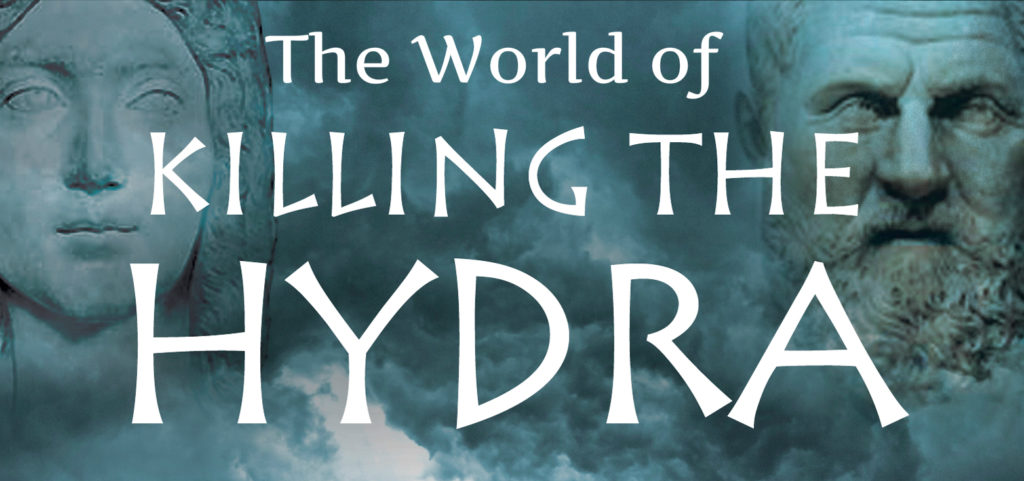
In this fourth installment of The World of Killing the Hydra, we’re going to look at a group of warriors who also have ties to myth, and who, as a fighting force, became legendary in the Roman world.
We are, of course, going to talk about the Sarmatians.
In Killing the Hydra, Lucius Metellus Anguis finds himself getting to know the men of the cavalry ala of Sarmatians who have been sent to join the III Augustan Legion at Lambaesis, in Numidia.
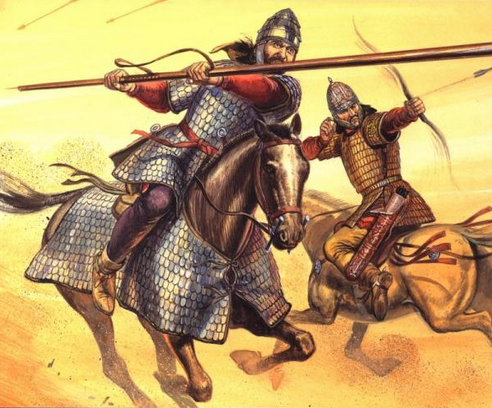
Artist impression of Sarmatian Cavalry
The leader of this fighting force is Mar, a king of his people who led them against Rome in the wars with Emperor Marcus Aurelius. Mar is joined by his royal nephew, Dagon, and both men play a key part in the story.
But who were the Sarmatians?
The average person has not heard about this group of warriors that came to form the elite heavy cavalry of the Roman Empire. Most people probably know of them only from the role they play in the movie King Arthur, with Clive Owen.
Researching Sarmatian warrior culture was a fascinating part of the research for Killing the Hydra.
The Sarmatians were a Scythian-speaking people from north of the Black Sea, and the high point of their civilization spanned from the 5th B.C. to the 4th century A.D. when they eventually went into decline because of pressure from the Huns and Goths.

Lance head of a Sarmatian ‘contos’, a 16 foot lance
The Sarmatians were a nomadic Steppe culture whose lands extended from the Black Sea to beyond the Volga in western Scythia.
Herodotus believed the Sarmatians (or ‘Sauromatae’) were descended from intermarriage between Scythian men and Amazon women, and that ever since the two peoples joined:
“the women of the Sauromatae have kept their old ways, riding to the hunt on horseback sometimes with, sometimes without, their men, taking part in war and wearing the same sort of clothes as men… They have a marriage law which forbids a girl to marry until she has killed an enemy in battle; some of their women, unable to fulfill this condition, grow old and die unmarried.”
(Herodotus, The Histories, Book IV)
Indeed Sarmatian grave discoveries have revealed armed women warriors, so it seems likely that such tales would easily have given rise to the Greek perception that the Sarmatians were descended from the Amazons, those beautiful and terrible daughters of Ares.
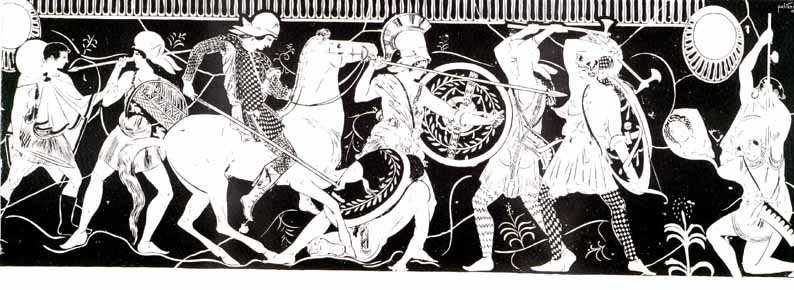
Amazons in battle
In Killing the Hydra, Mar, in conversation with Lucius, relates to the young Roman how the women of their people also fought:
“The women of our land are brave souls. We do not lock them up before the hearths of our homes. They are free to ride with us and wield the sacred sword. Some are priestesses and others have been gifted by our gods with foresight. Sarmatian women are nobler than what your Latin word ‘noble’ implies.”
(Mar, in Killing the Hydra)
And what of the men? Sarmatian men were fierce warriors and skilled horsemen, and according to the Roman writer Ammianus Marcellinus, they:
“…have very long spears and cuirasses made from smooth and polished pieces of horn, fastened like scales to linen shirts; most of their horses are made serviceable by gelding, in order that they may not at sight of mares become excited and run away, or when in ambush become unruly and betray their riders by loud neighing. And they run over very great distances, pursuing others or themselves turning their backs, being mounted on swift and obedient horses and leading one, or sometimes even two, to the end that an exchange may keep up the strength of their mounts and that their freshness may be renewed by alternate periods of rest.” (Ammianus Marcelinus, Roman History, Book XVII)
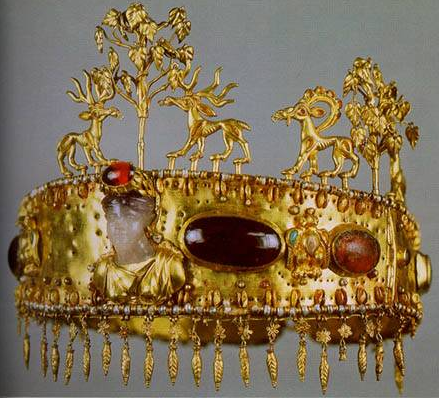
A Sarmatian crown
Sarmatian art and culture is also very rich.
Animal imagery was common in their artwork and often included such totem animals as dragons, griffins, eagles, sphinxes, snake women, and of course, horses. Often, these images were tattooed on their bodies.
The characters of Mar and Dagon are naturally curious about the dragon imagery on Lucius’ armour and weapons. They see it as a sign.
Also, if you remember the Sibyl’s prophecy from Children of Apollo, you will know that Lucius’ meeting with the Sarmatians is no coincidence.
The Sarmatians take their gods very seriously, but the one they most revered was their war god who was represented by the Sacred Sword.
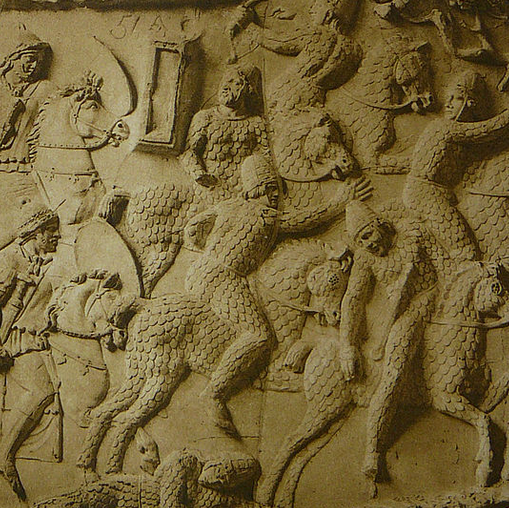
Sarmatian Warriors on
Trajan’s Column
The Sarmatians’ favourite trial of strength was single combat.
They believed that there was mystical power in battle, and when they defeated their enemies, it’s said they often took the heads, scalps, and beards of the vanquished, drinking blood from the skulls of the slain.
Ancient cultures often did have what we might perceive as barbaric rituals, but it’s sometimes difficult to detect truth in the midst of Greek and Roman propaganda or storytelling.
The picture painted does make for a wonderfully colourful group of warriors.
Despite the tales of fighting women, magic swords, scalping, and the drinking of blood, there is one fact that remains certain – the Sarmatians were some of the best cavalry the world had ever seen.
They were sometimes known as ‘lizard people’ because of their scale armour which covered both the horse and rider almost completely.
The Sarmatians were heavy cataphracts, the shock troops that were used to ride down the enemy while wielding their long swords, and the contos, a lance of about five meters, or sixteen feet long.
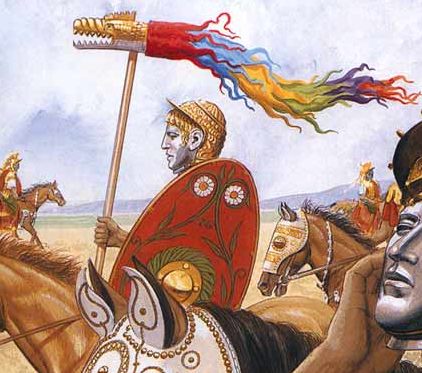
Artist impression of a
Draconarius carrying a Draco
The image that the Sarmatians are probably most known for, however, is the draconarius.
This was their war standard which they carried into battle. It consisted of a bronze dragon’s head with a long wind sock attached to it. It was held on a pole and carried at a gallop. When the wind passed through the draco, it made a loud howling sound that was said to terrify the enemy.
The draco was adopted as a standard by all Roman cavalry in the 3rd century A.D.
It’s amazing that, as a highly disciplined fighting force, the Sarmatians remained active for as long as nine centuries.
When Marcus Aurelius won a decisive victory over the Sarmatians in A.D. 175, he obtained an elite heavy cavalry for Rome that would make the auxiliaries much more of a force to be reckoned with.
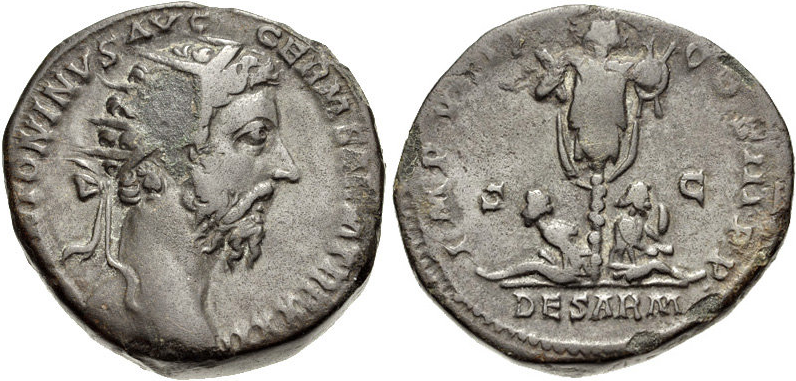
Coin of Marcus Aurelius showing Sarmatian captives
As ever, the Romans knew a good thing when they saw it.
In the aftermath of Rome’s victory, Marcus Aurelius obtained 8000 heavy Sarmatian cataphracts which became the most skilled cavalry of the age.
It is these warriors, descended from the Amazons and mighty Scythians of the Steppes, who now step into The World of Killing the Hydra.
Mar, Dagon, and their warriors turn the tides of war against the nomads in Numidia, and become an important new force in the life of Lucius Metellus Anguis.

Draco standard
The Dragons are now in the thick of it with the Eagles of Rome.
Thank you for reading.

Thank you for an accurate history review.
You’re very welcome, Jerry. Glad you enjoyed it. As an historian myself, I always aim for accuracy. 😉
I understand that they also served in Britain as evidenced by inscriptions and could well have been the mobile forces defending Britain left behind as they had after the withdrawal of the legions and went on to defeat the Saxons and hold them back from expansion in the west and north for a hundred years. Very good article. Thank you.
Glad you enjoyed this, James. And yes, you are right. There were inscriptions indicating a Sarmatian contingent in Britannia. Actually, you’ll see the Sarmatians in action in Britannia in the upcoming sequel to Killing the Hydra. I loved writing about them! More Sarmatian brilliance and mystery to come in the series, so stay tuned! Cheers for your comment.
Good article, Adam. Thank you.
This is a good article.
Question – the draco standard that is shown looks like the ones that I have seen for the Roma-Brition warrior chief Arthur, Pendragon.
Is there a connection ?
Thank you very much, Kenneth. I’m glad you liked it. And that is a VERY good question. One of my majors was Arthurian Studies, and I definitely believe there was an historical ‘Arthur’, a Romano-British warrior chief, as you say. The dragon figures largely in many cultures but the draconarius used by the Sarmatians, and later adopted by the Roman cavalry auxiliaries, does seem quite similar to the ones portrayed in early medieval manuscript images from Geoffrey of Monmouth, doesn’t it? Sarmatian cavalry ala were active in Britannia too. If you haven’t read it, I recommend Howard Reid’s book, Arthur: The Dragon King. It’s been a while since I read it but I remember his theories being quite plausible.
The topic you have opened up with your questions is a much bigger one deserving of more than my meagre comments here, suffice it to say for now that Yes, I do believe there is a connection, and I am going to explore that more and more as the Eagles and Dragons series progresses. In the upcoming Warriors of Epona (sequel to Killing the Hydra), we see a lot more of the Sarmatian ‘dragons’ on the battlefield 😉
Cheers and thank you for your comment.